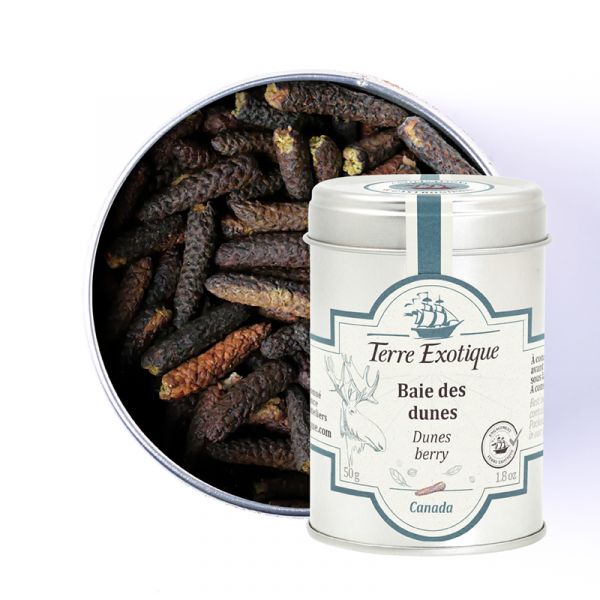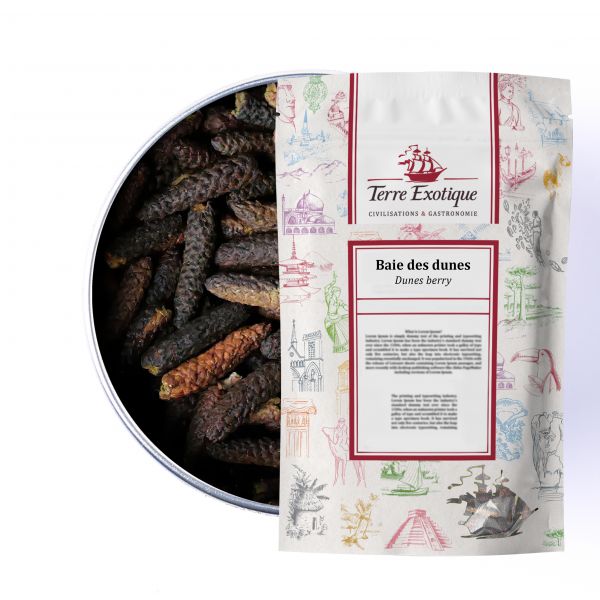



How to Use Dune Berries in Your Dishes?
Explore Northern Flavors with Dune Berries
We discovered dune berries thanks to our Canadian friends. During our numerous aromatic tests, we notably added a teaspoon of ground dune berries to our coffee before infusing it. The result was a success and it has become a classic in our home now: dune coffee!
How to Incorporate Dune Berries into Your Cooking?
Here are some recipe ideas to use dune berries in your cuisine:
- Grilled Flame Steak: Grill your steak on the barbecue and add 2 pinches of crushed dune berries.
- Homemade Mayonnaise with Dune Berries: Add 1 teaspoon of dune berries to your mayonnaise before whisking it.
- Fresh Goat Cheese Tartines with Dune Berries: Sprinkle a few pinches of crushed dune berries on your tartine.
- Chicken Broth with Dune Berries: Add 3 dune berries catkins to your broth during preparation to infuse.
- Grilled Sea Bass Fillet: Sprinkle a few pinches of crushed dune berries on the skin of your grilled sea bass fillet.
- Venison Steak: Marinate your venison steaks in olive oil with 1 teaspoon of dune berries before cooking.
- Fruit Salad with Dune Berries: Add 2 teaspoons of crushed dune berries to your fruit salad before serving.
The Gentle Aromas of Dune Berries
Dune berries have subtle aromas of mint and camphor. Both gentle and highly aromatic, dune berries give way to animal notes and fir aromas. This berry, not belonging to the pepper family, Piperaceae, does not sting at all and does not irritate the throat. It can therefore be used by everyone, and even the delicate palate of children will not be surprised!
A Boreal Root
What is Dune Berries?
Also known as sand dune pepper or alder pepper, dune berries are essential to North American cuisine. They come from the catkins of a small shrub that grows in the forests of Canada. The dune pepper, or dune berry, is hand-picked between autumn and winter.
The botanical name of dune berries is Alnus viridis. It belongs to the family of Betulaceae, like birches or hazels.
In Canada, and especially in Quebec, dune berries are called dune pepper because they are used to replace pepper on North American tables. At Terre Exotique, we pay attention to the botanical classification of plants to name them properly. Indeed, we make a distinction between pepper and berry. Dune berries do not belong to the Piper genus, so they cannot be called "pepper"; therefore, they are berries.
The History of Dune Berries
Dune berries were introduced by a figure in North American cuisine in the 1990s. In most Canadian grocery stores, you can find dune berries, under the name dune pepper. However, this berry is still rare in Europe, and those who have it are real lucky ones!
Its peppery and resinous flavors reveal its boreal origin and pair well with many dishes, which is why it is widely used in North American cuisine.
In Canada, dune berries are associated with game and fish cuisine. They are also used as survival food for campers in winter because they are very rich in protein.
Dune berries are harvested between October and December, just before the snow and winter sun attenuate the intensity of their fragrance. The harvesting is confidential; few know the locations where this exceptional berry grows, making it even more rare and coveted by gastronomy enthusiasts.
| Allergen | Absence |
|---|---|
| Native country | Canada |
| Genus and botanical species | Alnus viridis crispa |
| Ingredients | dunes berry |
| TRACES EVENTUELLES D'ALLERGÈNES | céleri, sésame, moutarde, fruits à coques. |
 Français
Français 